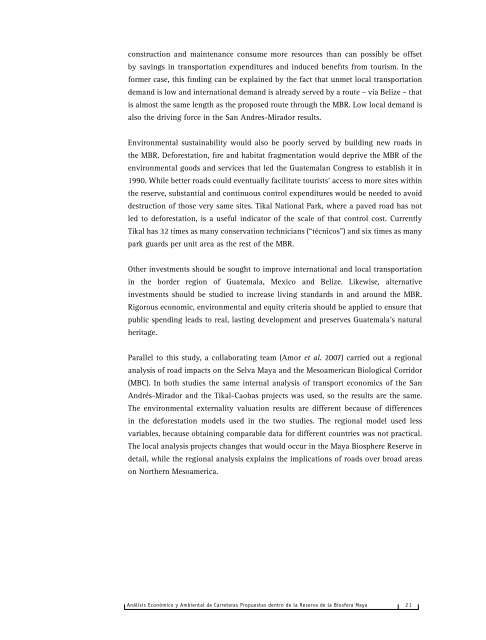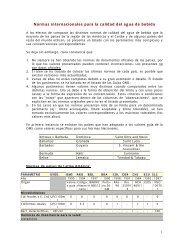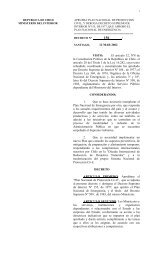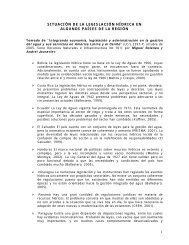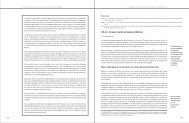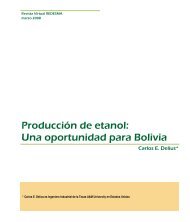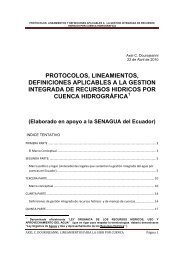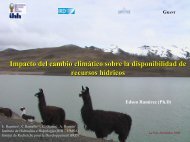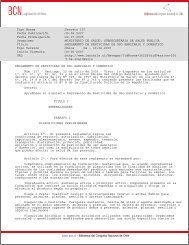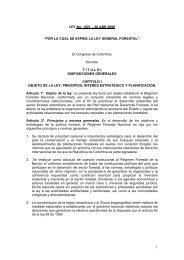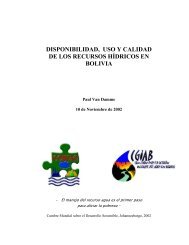New roads have been proposed within the Maya Biosphere Reserve (MBR), some linkingGuatemala to Mexico. The MBR is a 2 million-hectare protected area in NorthernGuatemala that encompasses part of the Maya Forest, which extends into Belize andMexico and is the largest remaining forest in Mesoamerica. Parts of the MBR are strictlyprotected, while others allow logging, agriculture and other human activities. Past roadbuilding in and around the MBR has been strongly associated with <strong>de</strong>forestation, andthere is little reason to suppose that future roads will be different in this regard. Thatmakes the projected future routes through the MBR a critical matter of conservationand <strong>de</strong>velopment policy.This study explores the costs and benefits of new roads in the MBR. We analyze theimpacts related to the <strong>de</strong>forestation and fires likely to be caused by the constructionof several routes: Uaxatún-Arroyo Negro, Carmelita-Mirador, Lagunitas-El Ceibo,Circuito Yaxhá-Nakum-Naranjo, Melchor <strong>de</strong> Mencos-Tres Ban<strong>de</strong>ras. We perform in<strong>de</strong>ptheconomic analyses of Tikal-Caobas and San Andrés-Mirador, because theyappear most likely to be constructed over the medium term. These analyses consi<strong>de</strong>r thecosts of construction and maintenance, and of lost forest goods and services. Weighedagainst these expenses are the benefits of cheaper and quicker transportation betweenand within Guatemala and Mexico, as well as easier access to tourist <strong>de</strong>stinations inGuatemala.Building the Tikal-Caobas route (which inclu<strong>de</strong>s Uaxatún-Arroyo Negro stretch), fromTikal north across the MBR to the Mexican bor<strong>de</strong>r, would generate a total net loss onthe or<strong>de</strong>r of US$ 54 million. US$ 14 million of the losses would be suffered by Mexicoand US$ 40 million by Guatemala. That result does not inclu<strong>de</strong> environmental costs.Deforestation could increase Guatemalan losses to more than US$ 56 million, due tothe <strong>de</strong>struction of timber, non-timber forest products and carbon stores.The San Andrés-Carmelita project would consist of paving the road from San Andrés toCarmelita, and building a new paved route from there to the El Mirador archeologicalsite. These roads would incur economic losses of US$ 21 million. That figure climbs toat least US$ 26 million in net losses when environmental costs are consi<strong>de</strong>red.Building all five new roads would result in the <strong>de</strong>forestation of at least 37,530 hectares bythe year 2025. In addition, we estimate that roads would cause 41,170 additional hectaresto burn between 2010 and 2015, with another 104,600 hectares consumed by fire between2020 and 2025. The roads would also result in significant habitat fragmentation, with aprojected 47% reduction of forest free from ecological “edge effects.”These results suggest that at least the Tikal-Caobas and San Andres-Mirador roadsrepresent poor investment choices. Their <strong>de</strong>velopment value is negative, because their2 0 CONSERVATION STRATEGY FUND ConservaCIÓN Estratégica SERIE TÉCNICA 8 abril <strong>de</strong> 2007
construction and maintenance consume more resources than can possibly be offsetby savings in transportation expenditures and induced benefits from tourism. In theformer case, this finding can be explained by the fact that unmet local transportation<strong>de</strong>mand is low and international <strong>de</strong>mand is already served by a route – via Belize – thatis almost the same length as the proposed route through the MBR. Low local <strong>de</strong>mand isalso the driving force in the San Andres-Mirador results.Environmental sustainability would also be poorly served by building new roads inthe MBR. Deforestation, fire and habitat fragmentation would <strong>de</strong>prive the MBR of theenvironmental goods and services that led the Guatemalan Congress to establish it in1990. While better roads could eventually facilitate tourists’ access to more sites withinthe reserve, substantial and continuous control expenditures would be nee<strong>de</strong>d to avoid<strong>de</strong>struction of those very same sites. Tikal National Park, where a paved road has notled to <strong>de</strong>forestation, is a useful indicator of the scale of that control cost. CurrentlyTikal has 32 times as many conservation technicians (“técnicos”) and six times as manypark guards per unit area as the rest of the MBR.Other investments should be sought to improve international and local transportationin the bor<strong>de</strong>r region of Guatemala, Mexico and Belize. Likewise, alternativeinvestments should be studied to increase living standards in and around the MBR.Rigorous economic, environmental and equity criteria should be applied to ensure thatpublic spending leads to real, lasting <strong>de</strong>velopment and preserves Guatemala’s naturalheritage.Parallel to this study, a collaborating team (Amor et al. 2007) carried out a regionalanalysis of road impacts on the Selva Maya and the Mesoamerican Biological Corridor(MBC). In both studies the same internal analysis of transport economics of the SanAndrés-Mirador and the Tikal-Caobas projects was used, so the results are the same.The environmental externality valuation results are different because of differencesin the <strong>de</strong>forestation mo<strong>de</strong>ls used in the two studies. The regional mo<strong>de</strong>l used lessvariables, because obtaining comparable data for different countries was not practical.The local analysis projects changes that would occur in the Maya Biosphere Reserve in<strong>de</strong>tail, while the regional analysis explains the implications of roads over broad areason Northern Mesoamerica.<strong>Análisis</strong> Económico y Ambiental <strong>de</strong> Carreteras Propuestas <strong>de</strong>ntro <strong>de</strong> la Reserva <strong>de</strong> la Biosfera Maya 2 1
- Page 1 and 2: Conservation Strategy Fund | Conser
- Page 3 and 4: Análisis económico y ambiental de
- Page 5 and 6: Agradecemos a Conservación Interna
- Page 7 and 8: Agradecimientos 4Índice 6Lista de
- Page 9 and 10: Tabla 1 - Descripción de tramos an
- Page 11 and 12: Figura 1 - Carreteras analizadas co
- Page 13 and 14: AAACOMACTCOMAIDBCIEBIDBTCCBTLTREBTN
- Page 15 and 16: {Resumen ejecutivoAnálisis Económ
- Page 17 and 18: En general, la construcción de las
- Page 19: {Executive summaryAnálisis Económ
- Page 24 and 25: Importancia y propósito del análi
- Page 26 and 27: Las carreteras analizadasCinco tram
- Page 28 and 29: Área de estudio: la Reserva de la
- Page 30 and 31: Sierra del Lacandón, probablemente
- Page 32 and 33: Actividades productivas tradicional
- Page 34 and 35: 3 4 CONSERVATION STRATEGY FUND Cons
- Page 36 and 37: DeforestaciónAntecedentesLa defore
- Page 38 and 39: MétodosEl requisito principal para
- Page 40 and 41: El modelo tiene, relativamente, baj
- Page 42 and 43: Tabla 3. Escenarios construidos a p
- Page 44 and 45: 4 4 CONSERVATION STRATEGY FUND Cons
- Page 46 and 47: Alto-Medio corresponden a los repor
- Page 48 and 49: IncendiosAntecedentesTres evaluacio
- Page 50 and 51: Tabla 6. Superficies quemadas por u
- Page 52 and 53: Modelamiento de los incendios y efe
- Page 54 and 55: Figura 11. Área afectada por incen
- Page 56 and 57: Tabla 9. Pérdidas de carbono por i
- Page 58 and 59: Tabla 11. Pérdidas en volumen de r
- Page 60 and 61: Tabla 13. Pérdidas en hojas de Xat
- Page 62 and 63: Tabla 14. Longitudes totales de bor
- Page 64 and 65: Figura 12. Áreas núcleo con buffe
- Page 66 and 67: MetodologíaSe realizó un análisi
- Page 68 and 69: proyecto generará para los guatema
- Page 70 and 71:
asado en el modelo más reciente HD
- Page 72 and 73:
Tabla 16. Distancias de Subteniente
- Page 74 and 75:
ingresa es de origen externo y, por
- Page 76 and 77:
actualmente no existe un camino 23
- Page 78 and 79:
En la Zona de Uso Múltiple se esti
- Page 80 and 81:
Tabla 23. VAN y TIR del Proyecto Ca
- Page 82 and 83:
Tabla 24. Valor de las emisiones de
- Page 84 and 85:
8 4 CONSERVATION STRATEGY FUND Cons
- Page 86 and 87:
Costos ambientales agregados de tod
- Page 88 and 89:
Los proyectos carreteros Tikal-Caob
- Page 90 and 91:
Es importante recalcar que las carr
- Page 92 and 93:
Alencar, A., Solórzano, L., Nepsta
- Page 94 and 95:
CONAP. 2003. Informe de estadístic
- Page 96 and 97:
Medellín, R. 1991. The Selva Lacan
- Page 98 and 99:
Secretaria de Comunicación y Trans
- Page 100 and 101:
Anexo 1 Valores de deforestación y
- Page 102 and 103:
807060Flores - BethelFlores - XanFl
- Page 104 and 105:
1.41.210.80.60.4Moran I0.20-0.2-0.4
- Page 106 and 107:
No Nombre corto Nombre largo Papel
- Page 108 and 109:
Anexo 3 Detalles de resultados del
- Page 110 and 111:
Tabla A5. Matriz de correlación de
- Page 112 and 113:
Anexo 4 Cálculos para la estimaci
- Page 114 and 115:
Anexo 5 Detalles de cálculos para
- Page 116 and 117:
Anexo 6 Descripción esquemática d
- Page 118 and 119:
Tabla A10. Pérdidas de carbono por
- Page 120 and 121:
Tabla A12. Especies por grupo comer
- Page 122 and 123:
Anexo 9 Desglose de costos del tram
- Page 124 and 125:
Anexo 10 Desglose de beneficios del
- Page 126:
Anexo 11 Costos totales, beneficios


